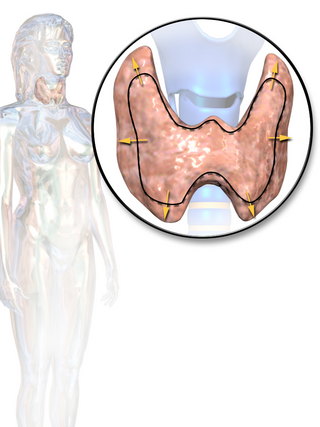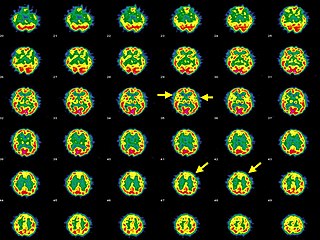Cause
| | This section is empty. You can help by adding to it. (October 2021) |
| Autoimmune hypophysitis | |
|---|---|
| Other names | Lymphocytic hypophysitis |
| Specialty | Endocrinology |
Autoimmune hypophysitis is defined as inflammation of the pituitary gland due to autoimmunity.
Autoimmune hypophysitis can lead to deficiencies in one or more pituitary hormones, causing central diabetes insipidus if the posterior pituitary gland is affected as well as central adrenal insufficiency and central hypothyroidism if the anterior pituitary gland is affected. [1] The symptoms depend on what part of the pituitary is affected. Lymphocytic adenohypophysitis (LAH) occurs when the anterior pituitary cells are affected by autoimmune inflammation resulting in either no symptoms, adrenal insufficiency (if the ACTH producing cells are affected), hypothyroidism (if the TSH producing cells are damaged), or hypogonadism (if the LH and/or FSH producing cells are involved). In some cases, the presence of inflammation within the pituitary gland leads to interruption of dopamine flow from the hypothalamus into the pituitary causing high levels of the hormone prolactin and, often as a consequence, milk production from the breasts (in older girls and women). Lymphocytic Infundibuloneurohypophysitis (LINH) occurs when the posterior pituitary is affected resulting in diabetes insipidus. Both LAH and LINH may also lead to symptoms of an intracranial mass such as headache or disturbance of vision, i.e. bitemporal hemianopia. The pituitary produces multiple hormones relating to various metabolic functions. Sufficiently low production of certain pituitary hormones can be fatal resulting in the failure of the thyroid or adrenal glands.[ citation needed ] Common symptoms include nausea, vomiting, fatigue, loss of libido, amenorrhea, and dizziness. [1] It is estimated that, typically, it takes from 12 to 40 years for autoimmune destruction to present symptoms. [2] However, there have been cases of isolated attacks as a result of drug reactions (i.e., use of blocking antibody ipilimumab) [3] [4] or idiopathic events that have presented symptoms which may disappear after relatively short term treatment (i.e., 1 year on corticoids or other immune suppressants). [5] However, more rapid development of the disorder is the rule when it occurs during, or shortly after, pregnancy (even after miscarriage or abortion). Indeed, autoimmune hypophysitis occurs more commonly during and shortly after pregnancy than at any other time. [6]
80% of patients with pituitary antibodies also have antibodies to thyroid gland or its hormones. [2] Likewise, 20% of autoimmune thyroid patients also have pituitary antibodies. [7] It follows that a subset of thyroid patients may have a disease related to autoimmune hypophysitis. Recent research has focused on a defect at the CTLA-4 gene which, coupled with other factors, may result in autoimmunity primarily focusing on certain endocrine glands including the pituitary and thyroid. [2]
| | This section is empty. You can help by adding to it. (October 2021) |
Lymphocytic hypophysitis continues to be a diagnosis of exclusion, and histopathology with tissue biopsy is needed for a definitive diagnosis.[3] However, clinical, laboratory data, and imaging can all help with the diagnosis.[8] First and foremost, patients present with symptoms of hypopituitarism and must undergo pituitary hormone function evaluation. [1] Biopsy is the only means of accurate diagnosis as no autoantigen has been discovered. [7] [8] Biopsy of the pituitary gland is not easily performed with safety as it sits under the brain, however, a test does exist to detect antibodies to the pituitary without biopsy: autoantibodies to M(r) 49,000 pituitary cytosolic protein may represent markers for an immunological process affecting the pituitary gland. [2] Tests for normal pituitary gland hormone production tend to be expensive and in some cases difficult to administer. In addition, certain hormone levels vary largely throughout the day and in response to metabolic factors, making abnormal levels difficult to calibrate—further hampering diagnosis. [9] [10] [11] [12] [13] [14] Assessment for other autoimmune and inflammatory diseases should also be performed by obtaining complete blood count, complete metabolic panel, c-reactive protein, erythrocyte sedimentation rate, antinuclear antibody, and lupus antibodies at the very least. Gadolinium-enhanced MRI of the pituitary is the imaging of choice as well, and it is important to distinguish lymphocytic hypophysitis from a pituitary adenoma. [1]
Inflammation resolves usually after several months of glucocorticoid treatment[ citation needed ] For those that show no improvement with corticosteroids or have relapsed after treatment with corticosteroids, immunosuppressive medications such as methotrexate, azathioprine, and cyclosporine can be used as well. There have also been some cases where dopamine agonists such as cabergoline/bromocriptine have also been successfully used in those with hyperprolactinemia due to pituitary inflammation. Surgery is only an option for those suffering from visual problems/ophthalmoplegia, have a mass like an effect from compression of nearby structures, or for those that require histology for diagnosis. [1]
A large scale study on cadavers done in Sweden, performed biopsies on hundreds of pituitary glands. The study indicated that perhaps as much as 5% of the population experiences some amount of autoimmune pituitary destruction. It is further hypothesized that perhaps half that many show, or may experience, clinical manifestations.[ citation needed ] The prevalence of all the types of hypophysitis is low, with an incidence of approximately 1 in 9 million. However, it is thought that this may be an underestimate, especially due to the recent use of immune checkpoint inhibitors for cancer treatments, which have endocrine side effects affecting the pituitary gland. [1] Although cases have been reported in children and the elderly, the mean age of diagnosis for men is 44.7 years, and the mean age of diagnosis for women is 34 years. [1]
Autoimmune attack of the pituitary gland resulting in reduced hormone production was first discovered as a result of an autopsy in 1962. The autopsy described destruction of the pituitary and thyroid consistent with autoimmune attack and included atrophy of the adrenal glands. [15] As magnetic resonance imaging became more available diagnosis increased dramatically. [15] At this time it is believed that the disease is far more prevalent than is diagnosed. [7] Nevertheless, autoimmune hypophysitis is frequently referred to as a rare disease and the most recent estimates as to its prevalence give it a value of around 5 per million. [16]

Graves' disease, also known as toxic diffuse goiter, is an autoimmune disease that affects the thyroid. It frequently results in and is the most common cause of hyperthyroidism. It also often results in an enlarged thyroid. Signs and symptoms of hyperthyroidism may include irritability, muscle weakness, sleeping problems, a fast heartbeat, poor tolerance of heat, diarrhea and unintentional weight loss. Other symptoms may include thickening of the skin on the shins, known as pretibial myxedema, and eye bulging, a condition caused by Graves' ophthalmopathy. About 25 to 30% of people with the condition develop eye problems.

Hypothyroidism is a disorder of the endocrine system in which the thyroid gland does not produce enough thyroid hormones. It can cause a number of symptoms, such as poor ability to tolerate cold, a feeling of tiredness, constipation, slow heart rate, depression, and weight gain. Occasionally there may be swelling of the front part of the neck due to goitre. Untreated cases of hypothyroidism during pregnancy can lead to delays in growth and intellectual development in the baby or congenital iodine deficiency syndrome.

Addison's disease, also known as primary adrenal insufficiency, is a rare long-term endocrine disorder characterized by inadequate production of the steroid hormones cortisol and aldosterone by the two outer layers of the cells of the adrenal glands, causing adrenal insufficiency. Symptoms generally come on slowly and insidiously and may include abdominal pain and gastrointestinal abnormalities, weakness, and weight loss. Darkening of the skin in certain areas may also occur. Under certain circumstances, an adrenal crisis may occur with low blood pressure, vomiting, lower back pain, and loss of consciousness. Mood changes may also occur. Rapid onset of symptoms indicates acute adrenal failure, which is a clinical emergency. An adrenal crisis can be triggered by stress, such as from an injury, surgery, or infection.

Adrenal insufficiency is a condition in which the adrenal glands do not produce adequate amounts of steroid hormones. The adrenal glands—also referred to as the adrenal cortex—normally secrete glucocorticoids, mineralocorticoids, and androgens. These hormones are important in regulating blood pressure, electrolytes, and metabolism as a whole. Deficiency of these hormones leads to symptoms ranging from abdominal pain, vomiting, muscle weakness and fatigue, low blood pressure, depression, mood and personality changes to organ failure and shock. Adrenal crisis may occur if a person having adrenal insufficiency experiences stresses, such as an accident, injury, surgery, or severe infection; this is a life-threatening medical condition resulting from severe deficiency of cortisol in the body. Death may quickly follow.

Hashimoto's thyroiditis, also known as chronic lymphocytic thyroiditis and Hashimoto's disease, is an autoimmune disease in which the thyroid gland is gradually destroyed. A slightly broader term is autoimmune thyroiditis, identical other than that it is also used to describe a similar condition without a goitre.

Hypopituitarism is the decreased (hypo) secretion of one or more of the eight hormones normally produced by the pituitary gland at the base of the brain. If there is decreased secretion of one specific pituitary hormone, the condition is known as selective hypopituitarism. If there is decreased secretion of most or all pituitary hormones, the term panhypopituitarism is used.

Sheehan's syndrome, also known as postpartum pituitary gland necrosis, occurs when the pituitary gland is damaged due to significant blood loss and hypovolemic shock usually during or after childbirth leading to decreased functioning of the pituitary gland (hypopituitarism). The pituitary gland is an endocrine organ, meaning it produces certain hormones and is involved in the regulation of various other hormones. This gland is located in the brain and sits in a pocket of the sphenoid bone known as the sella turcica. The pituitary gland works in conjunction with the hypothalamus, and other endocrine organs to modulate numerous bodily functions including growth, metabolism, menstruation, lactation, and even the "fight-or-flight" response. These endocrine organs release hormones in very specific pathways, known as hormonal axes. For example, the release of a hormone in the hypothalamus will target the pituitary to trigger the release of a subsequent hormone, and the pituitary's released hormone will target the next organ in the pathway. Hence, damage to the pituitary gland can have downstream effects on any of the aforementioned bodily functions.
An autoantibody is an antibody produced by the immune system that is directed against one or more of the individual's own proteins. Many autoimmune diseases are associated with such antibodies.

Thyroid disease is a medical condition that affects the function of the thyroid gland. The thyroid gland is located at the front of the neck and produces thyroid hormones that travel through the blood to help regulate many other organs, meaning that it is an endocrine organ. These hormones normally act in the body to regulate energy use, infant development, and childhood development.

Thyroiditis is the inflammation of the thyroid gland. The thyroid gland is located on the front of the neck below the laryngeal prominence, and makes hormones that control metabolism.

Adrenocorticotropic hormone deficiency is a rare disorder characterized by secondary adrenal insufficiency with minimal or no cortisol production and normal pituitary hormone secretion apart from ACTH. ACTH deficiency may be congenital or acquired, and its symptoms are clinically similar to those of glucocorticoid deficiency. Symptoms consist of weight loss, diminished appetite, muscle weakness, nausea, vomiting, and hypotension. Low blood sugar and hyponatremia are possible; however, blood potassium levels typically remain normal because affected patients are deficient in glucocorticoids rather than mineralocorticoids because of their intact renin-angiotensin-aldosterone system. ACTH may be undetectable in blood tests, and cortisol is abnormally low. Glucocorticoid replacement therapy is required. With the exception of stressful situations, some patients with mild or nearly asymptomatic disease may not require glucocorticoid replacement therapy. As of 2008 about two hundred cases have been described in the literature.
Pituitary apoplexy is bleeding into or impaired blood supply of the pituitary gland. This usually occurs in the presence of a tumor of the pituitary, although in 80% of cases this has not been diagnosed previously. The most common initial symptom is a sudden headache, often associated with a rapidly worsening visual field defect or double vision caused by compression of nerves surrounding the gland. This is often followed by acute symptoms caused by lack of secretion of essential hormones, predominantly adrenal insufficiency.

Subacute thyroiditis refers to a temporal classification of the different forms of thyroiditis based on onset of symptoms. The temporal classification of thyroiditis includes presentation of symptoms in an acute, subacute, or chronic manner. There are also other classification systems for thyroiditis based on factors such as clinical symptoms and underlying etiology.

The hypothalamic–pituitary–thyroid axis is part of the neuroendocrine system responsible for the regulation of metabolism and also responds to stress.

Hashimoto's encephalopathy, also known as steroid-responsive encephalopathy associated with autoimmune thyroiditis (SREAT), is a neurological condition characterized by encephalopathy, thyroid autoimmunity, and good clinical response to corticosteroids. It is associated with Hashimoto's thyroiditis, and was first described in 1966. It is sometimes referred to as a neuroendocrine disorder, although the condition's relationship to the endocrine system is widely disputed. It is recognized as a rare disease by the NIH Genetic and Rare Diseases Information Center.

Adrenal crisis is a potentially life-threatening medical condition requiring immediate emergency treatment. It is a constellation of symptoms that indicate severe adrenal insufficiency. This may be the result of either previously undiagnosed or untreated Addison's disease, a disease process that suddenly affects adrenal function, suddenly stopping intake of glucocorticoids or an intercurrent problem in someone known to have Addison's disease, congenital adrenal hyperplasia (CAH), or another form of primary adrenal insufficiency.

A pituitary disease is a disorder primarily affecting the pituitary gland.

An autoimmune disease is a condition that results from an anomalous response of the adaptive immune system, wherein it mistakenly targets and attacks healthy, functioning parts of the body as if they were foreign organisms. It is estimated that there are more than 80 recognized autoimmune diseases, with recent scientific evidence suggesting the existence of potentially more than 100 distinct conditions. Nearly any body part can be involved.

Hypophysitis refers to an inflammation of the pituitary gland. Hypophysitis is rare and not fully understood.
Hypothalamic disease is a disorder presenting primarily in the hypothalamus, which may be caused by damage resulting from malnutrition, including anorexia and bulimia eating disorders, genetic disorders, radiation, surgery, head trauma, lesion, tumour or other physical injury to the hypothalamus. The hypothalamus is the control center for several endocrine functions. Endocrine systems controlled by the hypothalamus are regulated by antidiuretic hormone (ADH), corticotropin-releasing hormone, gonadotropin-releasing hormone, growth hormone-releasing hormone, oxytocin, all of which are secreted by the hypothalamus. Damage to the hypothalamus may impact any of these hormones and the related endocrine systems. Many of these hypothalamic hormones act on the pituitary gland. Hypothalamic disease therefore affects the functioning of the pituitary and the target organs controlled by the pituitary, including the adrenal glands, ovaries and testes, and the thyroid gland.
{{cite journal}}: Cite journal requires |journal= (help)